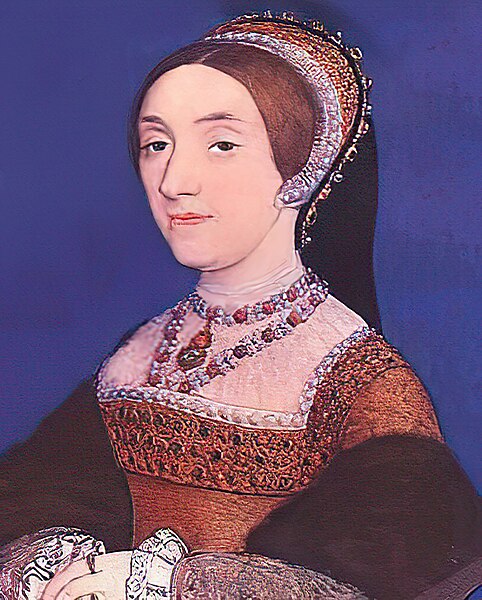This article provides a detailed exploration of significant historical events that occurred on February 13th across various years. By diving deeper into each event, we aim to offer insights into the impact these moments had on the course of history and the world.
From political shifts and groundbreaking discoveries to cultural milestones and significant advancements in science and technology, February 13th has been a date of importance across centuries.
Each segment below delves into events that highlight human achievements, struggles, and the relentless pursuit of progress, reflecting on how these events have shaped the societies we live in today.
February 13th Events in History
1542 – Catherine Howard, the fifth wife of King Henry VIII of England, is executed for adultery
On February 13, 1542, Catherine Howard, the fifth wife of King Henry VIII of England, was executed at the Tower of London. Catherine was a cousin of Anne Boleyn, Henry’s second wife, who was also executed.
Catherine’s short tenure as queen ended when allegations of her premarital affairs and an affair with Thomas Culpeper, a courtier, came to light. Her marriage to Henry VIII was annulled shortly before her execution.
Also Read: February 12 – On this Day in History
Catherine Howard’s tragic fate is often remembered as a stark example of the volatile nature of the Tudor court and the perilous position of women in the hierarchy of power.

1668 – Spain recognizes Portugal as an independent nation
The recognition of Portugal as an independent nation by Spain on February 13, 1668, marked the end of the 60-year period of the Iberian Union. This union began in 1580 when the crowns of Spain and Portugal were unified under King Philip II of Spain following a crisis of succession in Portugal.
Also Read: February 14th Events in History
The Portuguese Restoration War, which started in 1640, was fought to end the Spanish dominance. The Treaty of Lisbon, signed in 1668, formally recognized Portugal’s sovereignty, reinstating its independence and concluding a lengthy period of Spanish control over Portuguese territories.
1689 – The Glorious Revolution: William III and Mary II are proclaimed co-rulers of England
On February 13, 1689, William III and Mary II were proclaimed co-rulers of England, Scotland, and Ireland, marking a significant moment in British history known as the Glorious Revolution.
The event followed the deposition of Mary’s father, King James II, who was forced to abdicate the throne due to his Catholic faith and attempts to establish absolute monarchy.
The joint reign of William and Mary established constitutional monarchy as the foundation of British governance, significantly limiting the powers of the monarchy and enhancing those of Parliament.
1692 – The Massacre of Glencoe takes place in Scotland
The Massacre of Glencoe occurred in the early hours of February 13, 1692, in the Highland village of Glencoe, Scotland. The massacre was part of the government’s effort to suppress the Jacobite uprising.
Members of the Campbell clan, on orders from the government, attacked the MacDonald clan of Glencoe, who had been late in pledging allegiance to the new monarchs, William III and Mary II.
Approximately 38 MacDonalds were killed by their guests, and more died from exposure after their homes were burned. The event is remembered as a notorious betrayal and violation of the Highland code of hospitality.
1861 – Abraham Lincoln is officially declared winner of the 1860 U.S. presidential election
Abraham Lincoln was officially declared the winner of the 1860 United States presidential election on February 13, 1861. Lincoln’s election was pivotal, as it occurred at a time of profound national division over the issue of slavery.
His victory, without carrying a single Southern state, led to the secession of seven Southern states before his inauguration, and eventually four more followed after the Civil War began.
Lincoln’s presidency would become defined by the Civil War and his efforts to preserve the Union, as well as his issuance of the Emancipation Proclamation, which declared that all slaves in Confederate-held territory were to be set free.

1866 – Jesse James holds up his first bank, stealing $15,000 from the Clay County Savings Association in Liberty, Missouri
On February 13, 1866, Jesse James and his gang carried out what is considered the first successful daylight bank robbery in the United States during peacetime. The robbery took place at the Clay County Savings Association in Liberty, Missouri.
Jesse James, along with his brother Frank James and other members of their gang, stole approximately $15,000. This event marked the beginning of Jesse James’s infamous career as an outlaw and bank robber, which would captivate the American public and create a legend that persists to this day.
1880 – Thomas Edison observes the Edison effect
Thomas Edison, on February 13, 1880, observed what later came to be known as the Edison Effect. While experimenting with the electric light bulb, he noticed that a current flows readily from a heated filament to a cold plate inside a vacuum bulb but not in the reverse direction.
This discovery was the first known observation of thermionic emission, which became a fundamental principle in the development of vacuum tube technology.
Although Edison did not fully understand or pursue the implications of his observation, it would later form the basis for electronics, including radio, television, and computers.
1913 – The 13th Dalai Lama proclaims Tibetan independence from China
On February 13, 1913, the 13th Dalai Lama issued a proclamation that asserted Tibet’s independence from China. This historic declaration came after a tumultuous period in the region’s history, marked by aggressive incursions and interference by Qing Dynasty forces in Tibetan affairs.
The fall of the Qing Dynasty in 1912, which led to the establishment of the Republic of China, provided a political context in which the 13th Dalai Lama saw an opportunity to affirm Tibet’s sovereignty.
1920 – The Negro National League is formed in Kansas City, Missouri
The Negro National League, the first successful professional league for African American baseball players, was formed on February 13, 1920, in Kansas City, Missouri.
Founded by Rube Foster, a former player, manager, and owner for the Chicago American Giants, the league provided a platform for talented African American players who were barred from playing in Major League Baseball due to racial segregation.
The Negro National League is remembered for showcasing some of the greatest talent in the history of baseball and played a significant role in the eventual integration of Major League Baseball.
1945 – World War II: The Soviets capture Budapest, Hungary, from the German army
During World War II, on February 13, 1945, the Soviet Red Army captured Budapest, Hungary, from the German Army after a prolonged siege that began in December 1944. The battle for Budapest was one of the bloodiest encounters of the Eastern Front.
The city, which had been declared a fortress by Adolf Hitler, was defended by German and Hungarian forces and was subjected to intense Soviet artillery and air attacks.
The capture of Budapest was a strategic victory for the Soviets, opening the way to Vienna and significantly contributing to the eventual defeat of Nazi Germany.
1954 – Frank Selvy becomes the only NCAA Division I basketball player ever to score 100 points in a single game
On February 13, 1954, Frank Selvy, playing for Furman University against Newberry College, became the only NCAA Division I basketball player ever to score 100 points in a single game.
Achieving this remarkable feat before the three-point line was introduced, Selvy’s performance remains one of the most outstanding in basketball history.
He made 41 of 66 field goal attempts and 18 of 22 free throws. This historic game highlighted Selvy’s incredible scoring ability and ensured his place in college basketball lore.
1960 – France tests its first atomic bomb in the Sahara Desert, becoming the fourth country to do so
France conducted its first atomic bomb test on February 13, 1960, in the Sahara Desert, specifically at Reggane, in what was then French Algeria.
This test, codenamed “Gerboise Bleue” (Blue Jerboa), marked France as the fourth country to develop and successfully detonate a nuclear weapon, following the United States, the Soviet Union, and the United Kingdom.
The explosion signified France’s entry into the nuclear arms race and its determination to maintain a great power status and independence in its defense strategy during the Cold War.
1967 – American researchers discover the Madrid Codices by Leonardo da Vinci in the National Library of Spain
On February 13, 1967, American researchers discovered the Madrid Codices I and II in the National Library of Spain.
These two volumes, lost for over two centuries, contained about 2,000 pages of notes and drawings by Leonardo da Vinci, covering a wide range of topics, including mechanics, hydraulics, mathematics, and flight.
The discovery significantly expanded the known body of Leonardo’s work, providing new insight into the breadth of his genius and the interdisciplinary nature of his studies.
1971 – South Vietnamese ground troops launch an incursion into Laos to try to cut off the Ho Chi Minh trail and stop communist infiltration
On February 13, 1971, South Vietnamese ground troops, supported by U.S. air power and artillery, launched Operation Lam Son 719, an incursion into Laos.
The objective was to cut off the Ho Chi Minh Trail, a vital supply route for North Vietnamese forces into South Vietnam, and to reduce North Vietnamese pressure on South Vietnamese forces.
Despite initial success, the operation faced stiff resistance, and logistical difficulties and ended with heavy South Vietnamese casualties. The operation revealed the challenges of fighting in Laos and had mixed strategic results.
1974 – Aleksandr Solzhenitsyn, Nobel Prize-winning Russian novelist, is expelled from the Soviet Union
Aleksandr Solzhenitsyn, the Nobel Prize-winning Russian novelist and critic of the Soviet Union’s totalitarian regime, was arrested and expelled from the Soviet Union on February 13, 1974.
His literature, notably “The Gulag Archipelago” and “One Day in the Life of Ivan Denisovich,” exposed the harsh realities of the Soviet penal system and the broader suppression under Stalin’s rule.
Solzhenitsyn’s expulsion was part of the Soviet government’s broader effort to silence dissent, but it also turned him into an international symbol of resistance against oppression. He lived in exile, primarily in the United States, until returning to Russia after the dissolution of the Soviet Union.
1984 – Konstantin Chernenko succeeds the late Yuri Andropov as general secretary of the Communist Party of the Soviet Union
On February 13, 1984, Konstantin Chernenko succeeded Yuri Andropov as the General Secretary of the Communist Party of the Soviet Union, marking another leadership change in a period of rapid succession at the Soviet Union’s helm.
His tenure was noted for its continuation of Andropov’s policies without significant reforms or changes. His leadership was short-lived, however, due to his poor health, and he passed away in March 1985.
Chernenko’s era is often remembered as a time of stagnation, preceding the transformative period of perestroika and glasnost under his successor, Mikhail Gorbachev.
1991 – During the Gulf War, two laser-guided “smart bombs” destroy an underground bunker in Baghdad, killing hundreds of Iraqis
During the Gulf War on February 13, 1991, two laser-guided “smart bombs” were used by the United States to destroy an underground bunker in Baghdad, Iraq. This attack resulted in the deaths of hundreds of Iraqi civilians.
The U.S. military had believed the bunker was being used as a military command center, but it was later revealed that the bunker was also serving as a shelter for civilians. The incident sparked international controversy and highlighted the human cost of precision warfare.
2000 – The last original “Peanuts” comic strip appears in newspapers one day after Charles M. Schulz dies
On February 13, 2000, the last original “Peanuts” comic strip was published in newspapers, marking the end of an era for one of the most beloved and influential comic strips in history.
Charles M. Schulz, the creator of “Peanuts,” had passed away the day before, on February 12, making this final strip a poignant farewell from the artist.
Featuring characters such as Charlie Brown, Snoopy, and Lucy, “Peanuts” offered humor and insight into the human condition, earning a special place in the hearts of readers around the world.
2001 – An earthquake measuring 6.6 on the Richter scale hits El Salvador, killing at least 400
On February 13, 2001, El Salvador was struck by an earthquake measuring 6.6 on the Richter scale. This natural disaster caused widespread devastation across the country, resulting in the deaths of at least 400 people, injuring thousands, and leaving many homeless.
Coming less than a month after another major earthquake had hit the country, this event compounded the challenges faced by the Salvadoran people in their recovery efforts.
2008 – Australian Prime Minister Kevin Rudd makes a historic apology to the Indigenous Australians and the Stolen Generations
On February 13, 2008, Australian Prime Minister Kevin Rudd made a historic apology to the Indigenous Australians and the Stolen Generations.
In a landmark address to the Australian Parliament, Rudd apologized for the policies of forced removal of indigenous children from their families, a practice that had occurred in Australia throughout the 20th century.
This apology was a significant moment in Australian history, representing a formal acknowledgment of the injustices and suffering inflicted on Indigenous communities and an important step toward reconciliation.
